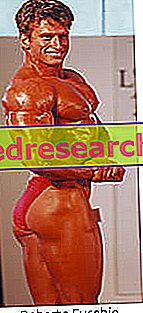Edited by Roberto Eusebio
Calm flat on the pectorals? All the builders know very well which are the particularly difficult muscle groups to hypertrophy: first of all the quadriceps as they are bulky - the most voluminous of the human body - and in secundis the pectoral ones, which we want to address in this article.

First of all it must be said that any chest workout goes through the "customs barrier" of the shoulders and arms, especially the forearms. And because to develop the chest we need strong manners, we will not be able to pretend to move and stabilize high loads of any kind with bony shoulders and forearms that resemble toothpicks: at best we will not obtain appreciable results, in the worst we will encounter an injury . So we will need some preparatory work on the shoulders and forearms.
For the shoulders I recommend four series carried to exhaustion and to increasing load of Arnold Press, movement certainly not among the simplest but also among the most tiring and complete. Prescription: once a week.
For the forearms, of which often the great body building people ignore who knows why existence, we will do: a retention of seated handlebars, first an arm and then, when the pain becomes unbearable, the other arm, three times below - and, similarly, of curl with a hammer grip on a 30 degree inclined bench. Prescription: twice a week. When we are able to hold six shopping bags with one hand it will mean that we will have worked enough on the forearms.
Finally a premise about the dip: determination! determination! determination! Let us not be discouraged if the first approach is disastrous, if we seem to be disarticulated puppets that do not manage to stand on parallel lines. Let's proceed step by step and let's make sure that next time we'll do better. Let us arm ourselves with patience and even our body will understand it and gradually it will give us green light.
The program for the chest is structured as follows: let's start with four sets of 15 repetitions of openings "elle" to warm the rotators of the shoulders. In the short pause between a series and the other we prepare three pairs of dumbbells with decreasing load in front of a flat bench. Once the heating is finished we will perform three superseries of distension with dumbbells with rest of 1 minute and a half in order to congest the pectorals and bring them quickly to an activated state. The weight difference between the handlebars will be 4 kg. Example for a superseries: 10 repetitions with 26 kg dumbbells, then immediately followed by 10 repetitions with 22 kg dumbbells and then another 10 with 18 kg dumbbells. two minutes of rest and let's be done with the parallel to the dip.
Let us have our feet crossed back and the torso tilted forward so as to involve the triceps as little as possible. We sink well down with the bust and do not turn our heads to look elsewhere: it just distracts. We stare straight ahead and try to perceive work within the mass of the breastplate. We perform a first series of ten repetitions done correctly. Starting from the second-third month of training, when we are now able to easily complete three sets of 10 or 12 free-body repetitions, it will be time to give ourselves seriously and apply overweight.
We wear a belt to the waist, hook a chain and hang a 10 kg disc, then off with the second and third series of dip conducted to exhaustion. It is from this moment on that the pectorals will begin to really grow. I managed to bear an overweight of 25 kg, which I thought was more than enough; I do not know what can happen but I would stop here to avoid playing my back, which for the record must say that they will be put to the test by this exercise. So overweight is welcome but be careful not to overdo it - let's try to recognize and respect our limits and put aside exhibitionisms.
We end with a fourth and last series also conducted to exhaustion but without overweight: it will seem to us to fly and we will come out with two pectoral to scream. We continue the workout by performing three series of 10 repetitions of crosses to high cables. We will thus exploit the hyper warm-up of the pectorals obtained at the dip and the psychological gratification given by having completed that exercise to give definition to this muscular district that we want to explode: a bit like the final touches to a picture that we are about to finish . Once the crosses are over the high cables, if we still have the energy to spend we can run four series close to descending load at the Pectoral Machine until we squeeze the last fiber. At the end of this we will go to the nearest mirror to check the results and then we will be free to fall to the ground. Seriously, I recommend using this routine once a week for six months and no more.
Dip with overweight is a splendid exercise, the most effective I have ever experienced, but also burdensome for the shoulder joint, a complex nodal point that we must preserve at all costs from injuries. With a program of this type the results will not be long in coming, and unless they are genetically disadvantaged, they will exceed all our most optimistic expectations - and in the end, when we will boast such numbers that we can be hired as rowers in a Roman ship, we can proudly : the flat bench? Only a distant memory.



